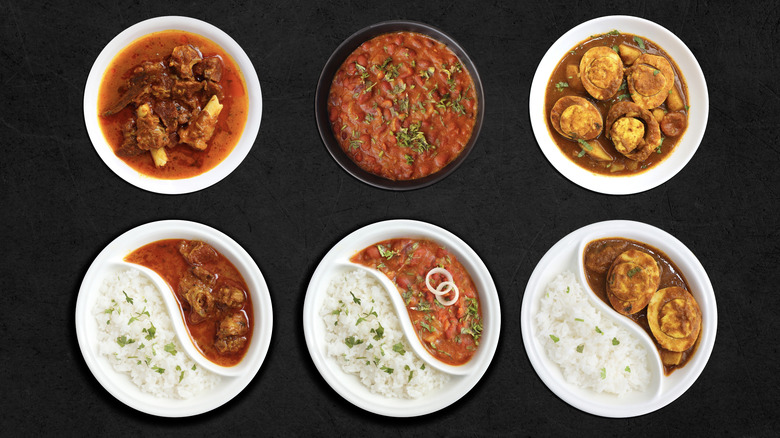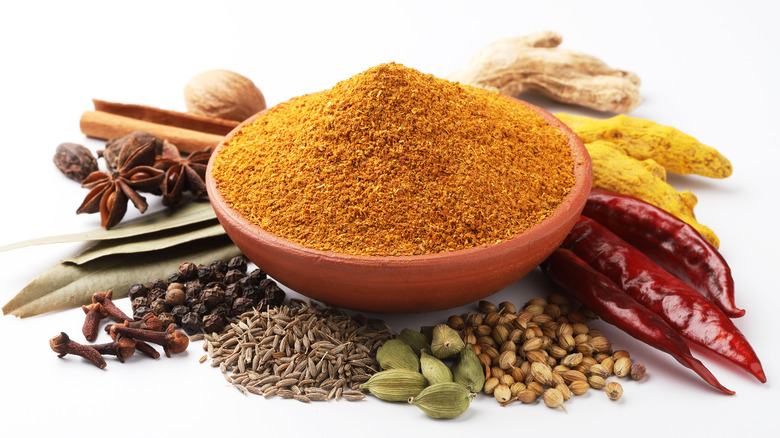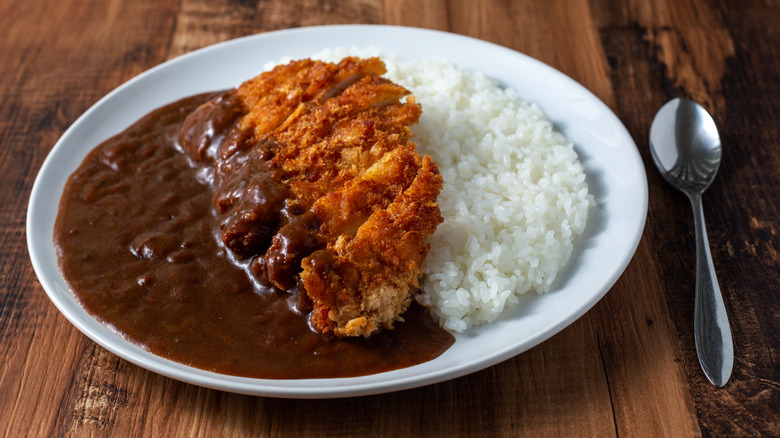'Curry' Isn't Actually An Indian Word. Here's Where It Comes From
What is curry? That's a weirdly difficult question to answer, isn't it? For the name of a dish to become so widely known yet remain so poorly defined is frankly quite impressive. If you tried to picture curry in your mind's eye, there are so many things your brain could display. There's Jamaican curry with goat meat, Indonesian beef rendang in a coconut sauce, sweet caramel-colored Japanese curry, and that beloved staple of German street food that is currywurst. Considering all its implications, 'curry' can best be summed up as a dish with some kind of spiced sauce or gravy. That's hardly a satisfying definition, but it's the best one can do.
Admittedly, most Western readers probably saw the word 'curry' here and immediately thought of Indian cuisine. Multiple Indian dishes have been grouped under the curry label, including vindaloo, korma, rogan josh, and rajma masala. The ever-popular chicken tikka masala often gets thrown on that list as well, and it may actually be the best curry case study because its history follows a similar trajectory to the word itself. Tikka masala was born from the cultural crossover that happened when Britain colonized India and Pakistan. The classical origin story says that a Bangladeshi chef in London fused chicken tikka (traditionally a kebab-style skewer) with the creamy sauce of North Indian butter chicken in an attempt to please the British palate. In a similar fashion, the word 'curry' as we know it came from England, but it has multicultural sources.
Where 'curry' comes from (we think)
The exact origins of curry are not 100% certain. The term does not appear in any of India's official languages, though it's widely believed to have evolved from the Tamil word 'kari,' which refers to a type of thin sauce served over rice. Oddly enough, 'curry' likely entered the English language by way of Portuguese. In 1498, over a century before the British arrived in India, the Portuguese came through and introduced chili peppers to the subcontinent. This forever changed South Asian cuisine, and multiple Indian dishes, notably vindaloo, have Portuguese roots. At the same time, Portuguese in the Tamil-speaking region likely encountered the term 'kari,' which they transliterated as 'caril' or 'caree.'
It's believed that the British first discovered the Portuguese version of the word in a 16th-century travelog, transliterating it once again to bring it even further from the initial Tamil spelling. However, spelling didn't count for much at this point, as the Portuguese had broadened the term by applying it to almost any spiced, stew-like dish, a trend the British would continue. In 1747, a recipe for 'curry' was published in "The Art of Cookery Made Plain and Easy" by British cook and author Hannah Glasse, and by the late 1700s, premade curry powder was available in stores. By the 20th century, the English had expanded their use of 'curry' to refer to an entire style of cuisine, featuring rich, cream-based sauces in the North Indian Mughlai tradition.
How 'curry' came to have so many meanings
We've seen how the Portuguese and British stumbled upon the word 'curry' and applied it to Indian cuisine, but where did all these other curries — the Jamaican, the Japanese, the German, etc. — come from? Even though those dishes are much different than their Indian counterparts, they all call for some version of a spice mixture labeled 'curry powder,' which has no strict definition but typically contains turmeric as the main ingredient. Though curry powder originated in Britain, it was inspired by Indian spice blends like garam masala. As the British Crown expanded its influence across the globe, curry powder spread alongside it, entangling with many other cultures.
In the mid-1800s, British merchants introduced curry powder to Japan, where the locals started using it to flavor a roux-based gravy. Today, it's often served over fried pork cutlets in a dish called katsu karē. The British also colonized multiple Caribbean islands, in some cases bringing indentured laborers over from India. This brought curry powder to Jamaica, Guyana, Saint Kitts and Nevis, and Trinidad and Tobago. Similar stories played out in South Africa, Malaysia, and Indonesia. Some of the countries that got curry through Britain then passed it along to other cultures, continuing the chain of influence. When the Japanese took control of Korea during WWII, curry changed hands again, marking five degrees of curry separation from India to Portugal to Britain to Japan to Korea.


